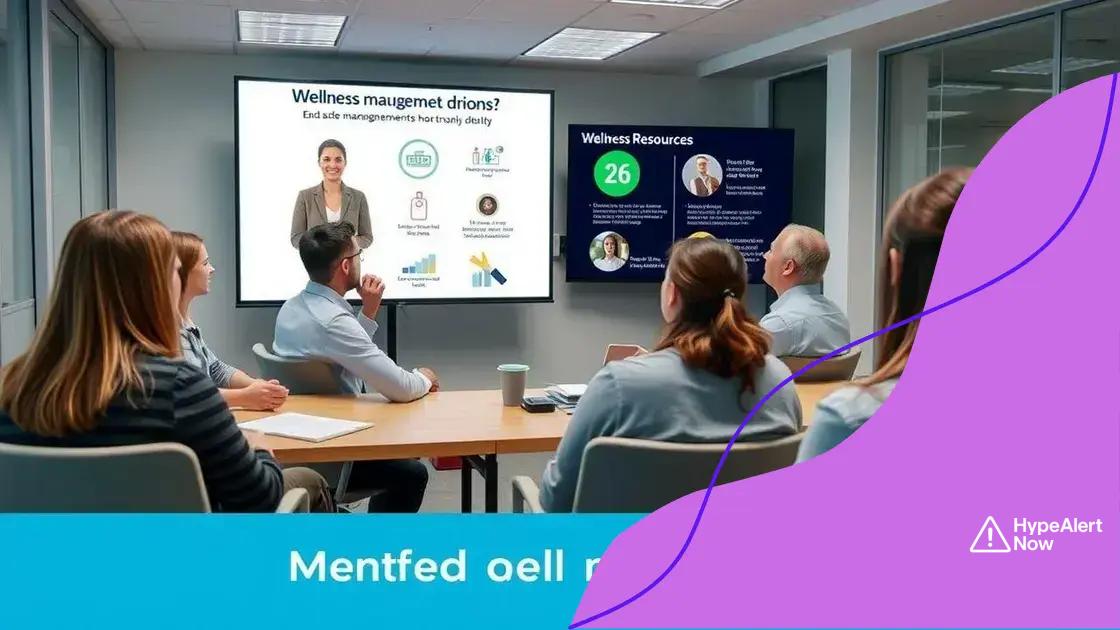Workplace mental health support in the U.S. is vital

Workplace mental health support in the U.S. involves implementing effective programs, utilizing technology, and promoting an open culture to enhance employee well-being and productivity.
Workplace mental health support in the U.S. has become more important than ever, as organizations recognize the impact of mental well-being on productivity. It’s essential to explore how effective support can transform company culture.
Understanding workplace mental health
Understanding workplace mental health is essential for creating a supportive environment. Employees often face challenges that can affect their mental well-being. Recognizing these issues is the first step towards improvement.
Important Aspects of Workplace Mental Health
There are several key factors in understanding how mental health affects employees:
• Stress levels
• Work-life balance
• Supportive leadership
By focusing on these areas, companies can foster a healthier atmosphere. Providing resources for mental health support is crucial.
Recognizing Signs of Mental Health Issues
Employers need to be attentive to signs of mental health struggles among their teams. Some common signs include:
• Decreased productivity
• Increased absenteeism
• Changes in behavior
• Withdrawal from team interactions
Encouraging open communication can help address these issues promptly. Employees should feel safe discussing their mental health without fear of judgment.
Furthermore, creating programs that promote mental health awareness is vital in workplaces. Workshops and training sessions can equip employees with the knowledge to manage stress effectively. When organizations prioritize mental health, they not only support their employees but also enhance overall productivity.
In summary, understanding workplace mental health involves recognizing the importance of individual well-being within the organizational structure. A culture of support and open dialogue can lead to healthier workplaces for everyone.
Key challenges in mental health support
Key challenges in mental health support are prevalent in many workplaces today. Understanding these obstacles is necessary for creating effective support systems. Common hurdles can significantly impact employee well-being and overall productivity.
Stigma Around Mental Health
One major challenge is the stigma associated with mental health issues. Employees may feel ashamed or embarrassed about seeking help. This stigma can prevent them from talking about their struggles with colleagues or management.
- Fear of judgment or criticism
- Lack of understanding among peers
- Perception of weakness
Education and awareness programs can help to reduce stigma. When organizations promote an understanding of mental health, employees may feel more comfortable discussing their needs.
Limited Access to Resources
Another obstacle is the limited access to mental health resources. Many employees may not know what services are available to them. Some companies lack proper mental health programs or benefits, which can leave employees feeling unsupported.
- Inconsistent availability of mental health services
- Insufficient training for managers
- Financial constraints on employee benefits
To address this, companies should assess their current offerings and strive to improve them. Providing comprehensive employee assistance programs (EAPs) is one way to ensure employees have access to the help they need.
Additionally, communication plays a critical role in overcoming these challenges. Regularly sharing information about available resources reinforces their importance. Providing platforms for employees to voice their concerns can also foster a supportive culture.
In conclusion, acknowledging and addressing the key challenges in mental health support is essential. By creating a supportive environment, organizations can help improve employee well-being and promote a healthier workplace culture.
Effective mental health programs for employees

Effective mental health programs for employees are essential in promoting a healthy work environment. These programs offer tools and support that can significantly enhance employee well-being.
Components of Successful Programs
A successful mental health program includes several key components. These are designed to address various aspects of mental well-being:
• Accessible resources and services
• Training for managers and staff
• Flexible work arrangements
Organizations should ensure that these components are readily available. When employees have easy access to mental health resources, they are more likely to seek help when needed.
Types of Programs
There are different types of mental health programs that can be implemented in the workplace. Some common options include:
• Employee Assistance Programs (EAPs)
• Wellness workshops or seminars
• Stress management training
These programs can provide employees with the necessary skills to manage their stress. Interactive sessions often lead to better engagement and understanding of mental health issues.
Furthermore, companies should encourage open dialogue about mental health. Creating a culture of support can help reduce stigma and promote engagement. Regular check-ins and mental health days can also demonstrate a company’s commitment to its employees’ well-being.
In addition, tailoring programs to meet the specific needs of the workforce can enhance their effectiveness. Surveys and feedback from employees can guide the development of initiatives that resonate with their experiences.
Overall, investing in effective mental health programs can lead to a more engaged and productive workforce. By prioritizing mental health, organizations can create environments where employees thrive.
The role of HR in mental health support
The role of HR in mental health support is crucial for fostering a positive workplace environment. Human Resources professionals are responsible for implementing programs and policies that prioritize employee well-being.
Creating Awareness and Training
HR teams should lead initiatives that raise awareness about mental health. This includes organizing training sessions for managers and employees. Training helps everyone understand the importance of mental health and how to support one another.
- Identify signs of mental health issues
- Provide resources for support
- Encourage open communication
By equipping staff with proper knowledge, HR can create a supportive culture where employees feel comfortable discussing their mental health.
Implementing Policies and Programs
An effective HR department will develop and implement policies that support mental health. This can include flexible work arrangements, providing Employee Assistance Programs (EAPs), and creating mental health days.
These initiatives can contribute significantly to employee satisfaction and productivity. HR should seek feedback from employees to improve existing programs and create new ones that meet their needs.
Additionally, HR can play a key role in promoting work-life balance. By encouraging a culture that values personal time, HR helps reduce stress and prevent burnout among employees. This balance is vital in supporting overall mental health.
In summary, HR’s involvement in mental health support is essential for building a workplace that values psychological well-being. Their commitment to creating supportive policies and promoting awareness can lead to a healthier and more engaged workforce.
Future trends in workplace mental health
Future trends in workplace mental health are shaping how organizations approach employee well-being. As awareness grows, companies are beginning to implement innovative strategies to support their staff.
Increased Use of Technology
One significant trend is the increased use of technology in mental health support. Many organizations are adopting apps and online platforms that offer resources and virtual therapy.
• Mental health apps for daily check-ins
• Online therapy services
• Virtual workshops and support groups
These technological solutions make mental health resources more accessible, allowing employees to seek help conveniently.
Focus on Preventative Measures
Another trend is the shift towards preventative measures instead of reactive solutions. Employers are now understanding the value of proactive mental health strategies. Companies are increasingly offering:
• Mindfulness training
• Stress management programs
• Physical wellness initiatives
By focusing on prevention, organizations can reduce the likelihood of mental health crises, ultimately leading to a healthier workforce.
Moreover, workplaces are beginning to recognize the importance of diversity and inclusion in mental health discussions. Acknowledging different cultural backgrounds can lead to more tailored support approaches. Employers will benefit from understanding the unique mental health challenges faced by diverse teams.
Additionally, companies are prioritizing creating a culture of openness. This culture encourages employees to discuss their mental health without fear of stigma. More organizations are implementing mental health days as part of their employee benefits, promoting the significance of taking time off to recharge and focus on personal well-being.
In conclusion, the future of workplace mental health emphasizes technology, preventative measures, and cultural awareness. Adopting these trends can create a more supportive environment for all employees, enhancing their overall mental well-being.
FAQ – Frequently Asked Questions about Workplace Mental Health
What are the benefits of mental health programs in the workplace?
Mental health programs improve employee well-being, reduce absenteeism, and increase productivity.
How can technology support mental health in the workplace?
Technology can provide accessible resources, such as apps and online therapy, making support available anytime.
What role does HR play in mental health support?
HR is responsible for implementing policies, training, and resources that promote mental health awareness and support.
Why is addressing stigma around mental health important?
Addressing stigma encourages open communication and helps employees feel safe seeking help, improving workplace culture.
